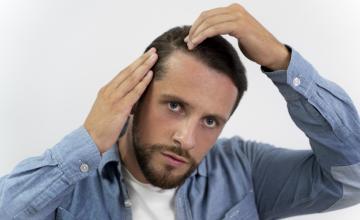Damkerng Pathomvanich, MD



The most important decision in restoring your hair is the physician you choose. The skill, talent, and experience of hair restoration physicians vary widely, as do the end results. Who you choose will determine how natural and full your new hair will be for the rest of your life.
Since performing follicular unit hair transplantation is very demanding upon a clinic’s physician and staff only a minority of hair restoration clinics perform it successfully. Unfortunately, many clinics are still unwilling or unable to dedicate the time and resources required to master and perform this procedure successfully.
Therefore, those seeking only the most natural results need to be very selective. Keep in mind that in the United States any licensed physician can perform hair restoration surgery without any special certification or training. If you do not find an excellent hair restoration surgeon in your local area seriously consider traveling out of state to get your hair restored properly. After all, the results will last a lifetime.
How many years has the physician been dedicated to doing hair restoration?
How many hair restoration procedures does the surgeon perform in one day? Ideally the physician will be dedicated to working on you all day if you are doing a large mega session procedure.
Does the physician perform hair restoration surgery full time or predominantly? If not, the clinic may not have a staff that is experienced enough to successfully perform large sessions of all microscopically prepared Follicular Unit (FU) grafts.
What is the hair restoration surgeon's reputation among his or her peers?
Does the physician take a holistic approach to hair loss treatment and also offer advice or Rogaine?
What procedure does the clinic perform? Is it truly state of the art?
Does the physician use microscopes for the dissection of the donor tissue into 1, 2, 3, and 4 hair Follicular Unit (FU) grafts?
Large sessions of all microscopically prepared grafts are a team effort. But how "hands on" will your hair restoration surgeon be? Will he or she be making all the incisions in the graft recipient area, thus determining the design and hair direction of your transplanted hair? How involved will your surgeon be in the placing of the actual grafts?
Trust but Verify – Review Patient Results
Can the surgeon provide a list of names and phone numbers of patients willing to discuss their personal experiences? Patient testimonials will say a lot.
Can the surgeon provide at least one dozen sets of clinical "before" and "after" case photos for your review? Be sure the photos offer good clarity and detail and include "before" views as well as "after" views that allow for critical evaluation.
Verify claims by visiting online discussion forums and searching for previous posts regarding a hair transplant physician you are considering.

Our member physicians are carefully reviewed and granted membership in the Coalition based on their high level of ethics, skill, and the quality of their patient results.
Learn more about our network of quality prescreened physicians.





If you are going bald you should seriously consider hair loss medication treatments to halt or even reverse your hair loss. While there is no “Hair Loss Cure”, hair loss drugs like finasteride (Propecia) and dutasteride (Avodart) can often stop or even reverse alopecia areata in most people.
However, just like any other drug, Propecia is accompanied by a list of potential side effects, some of which have been more recently reported as potentially long term. You can read more about this in the "What About Side Effects" section further down this page.
Studies have shown that 80% of men using Propecia stopped or even reversed their hair loss to some degree. Preliminary clinical trials for Avodart appear even more effective than Propecia.
However, neither Propecia nor Avodart has been proven to restore hair in the frontal areas. For reasons yet unknown these drugs, along with Rogaine, only generally work in regrowing thinning hair in crown area of the scalp. Only hair transplant surgery has been successful in restoring hair in the frontal hairline area once it has been lost.
Propecia and Avodart are also less effective in growing hair in older men. These hair loss drugs work best for men who have been balding for less than five years.
Both Propecia and Avodart are not recommended for use by women or children.
It’s been found that these drugs can cause birth defects. More specifically, these birth defects may occur when large amounts of the drug are absorbed into the body during the period of foetal development.
Physicians advise pregnant women to not handle Propecia tablets, as this may harm male foetuses. But as of yet, there has not been a single reported case of birth defects caused by handling these tablets.
Furthermore, there’s also no evidence that pregnant women exposed to the semen of Propecia or Avodart patients will risk any birth defects.
Propecia and Avodart are also not advisable for men with liver disease or prostate cancer.
Often our member physicians will prescribe Propecia or Avodart to halt a patient’s hair loss and then restore the hair already lost with hair transplant surgery. These treatments in combination can work synergistically. The drugs work to halt the hair loss, while hair restoration surgery restores what was lost.
To get a prescription for Propecia or Avodart schedule a free no obligation consultation with any of our quality hair restoration physicians. Find a physician in your area.
Propecia and Avodart should be taken once a day. It has been found that after two years of treatment, Propecia effectively grows hair in about 66% of patients. Also, about 83% of the subjects receiving this treatment continue to maintain their existing hair after two years.
Propecia (Finasteride) was originally a drug called Proscar, which was used to treat and reduce men's prostate conditions such as benign prostatic hyperplasia (BPH).
Its parent company, Merck & Co., soon realized that the drug had a unique side effect - it grew hair on bald men's heads.
In December 22, 1997 the FDA approved Propecia as a hair loss pill. Merck & Co. then marketed the drug as a hair loss treatment under the trade name of Propecia.
More recently Dutasteride, sold as Avodart, has generated interest as a promising new hair loss medication. Like finasteride (Propecia) it inhibits the creation of DHT and was originally developed as a treatment for men’s prostate condition.
However, unlike Propecia, Avodart inhibits the creation of both type one and type two 5 alpha reductase enzymes. Dutasteride has been shown to decrease levels of DHT by 90% after only two weeks, making it a more powerful and faster acting weapon against hair loss than Propecia (Finasteride).
Dutasteride is not yet FDA approved for the treatment of hair loss. However, some hair restoration physicians also prescribe it for the treatment of hair loss. Like Propecia, Avodart is not safe for women and children.
Losing your hair took time. So too will regrowing your hair using Propecia or Avodart. These drugs require patients to take the drug daily for at least three months before any obvious changes will be noticeable. Most physicians advise taking these drugs for a year before evaluating their effectiveness.
At this time, Propecia and Avodart are only available by prescription. Our member physicians are available to discuss these hair loss drugs with you and prescribe them if appropriate. To find a quality hair restoration physician in your area.
Aside from Propecia and Dutasteride, there are other treatment options (all topical) that may or may not work to block the effects of DHT on vulnerable hair follicles. These include Revivogen, Crinagen, Progesterone Creams, and Xandrox (a type of minoxidil). Other DHT Blockers
To learn more about these treatments, as well as all other topical options, visit our Topical Hair Loss Products and Treatments section.
Baldness is largely the result of dihydrotestosterone (DHT) interacting with those hair follicles that are genetically vulnerable to their effects.
DHT is essentially the active ingredient or catalyst for the hair loss process. DHT binds with the receptor sites of genetically vulnerable follicles and gradually degrades the follicles ability to produce healthy hair. This eventually results in baldness in the affected areas.
Hair loss drugs like Propecia or Avodart work by inhibiting the conversion of testosterone into dihydrotestosterone (DHT). By reducing the amount of DHT present in the scalp the hair loss process is slowed and in some cases even reversed.
Up until a couple of years ago, side effects when taking Propecia or Avodart were only considered temporary. However, over the last several years, many me have reported ongoing side effects from Propecia even after stopping treatment. This more permanent condition has become known as "Post Finasteride Syndrome" or (PFS). Side effects included but aren't limited to reduced semen production, a reduced libido and softer erections.
As a result, in April of 2012, the FDA mandated labeling changes to finasteride related products. Labeling changes to Propecia include "libido disorders, ejaculation disorders, and orgasm disorders that continued after discontinuation of the drug". Labeling changes to Proscar include "decreased libido that continued after discontinuation of the drug". Labeling changes to both Propecia and Proscar include "reports of male infertility and/or poor semen quality that normalized or improved after drug discontinuation".
While most men don't experience any side effects at all, it should be known that a small percentage of men may experience persistent side effects even after stopping treatment. Most men who experience side effects however, only experience them temporarily and stopping treatment makes them go away.
For a list of potential side effects and more information on Post Finasteride Syndrome", visit http://www.pfsfoundation.org/.

Viviscal's hair growth vitamin and dietary supplement taken twice daily promises to "reverse hair loss" and grow thicker hair in both men and women experiencing balding and thinning hair. Its primary activeingredient, AminoMar C™ Marine Complex, is said to be a proprietary blend of ingredients and proteins that "provides the essential nutrients needed to nourish thinning hair and promote existing hair growth".
The entire Viviscal product line includes an "all natural" dietary supplement, a shampoo and conditioner, and a scalp lotion. Viviscal is promoted as being 100% natural, drug-free, gluten-free and safe from harmful side effects. But can Viviscal deliver on its promises to reverse hair loss and grow new hair?
In 2011, Viviscal advertisement was banned in the United Kingdom by the Advertising Standard Authority (ASA) who deemed that its claims to maintain optimum hair health were unproven. The ASA concluded:
"Because the evidence sent did not show that the ingredients in Viviscal had been shown to have a positive effect on hair health, we concluded the claims that the product could 'nourish hair follicles' had not been substantiated' and ruled the advert cannot be broadcast until it is changed."
However, as with many similar products promising to grow hair, substantiating their hair growth claims may not be a simple task.
Viviscal’s manufacturer does reference a number of studies that seem to support their claims of growing thicker hair. For example, the results of "Scientific Pilot Study #1" on 40 hair loss suffering females with an average age of 35 concluded, "Viviscal was well received by test subjects and the analysis of hair counts showed a mean reduction in hair loss of 46% in only 10 weeks." Additional studies are cited on Viviscal’s website.
Recently, we learned that Dr. Glenn Charleshas publicly endorsed Viviscal. Dr. Charles has an outstanding reputation for performing state of the art hair transplant surgery and is a highly esteemed member of the Coalition of Independent Hair Restoration Physicians.When asked to comment on his public endorsement of Viviscal, Dr. Charles stated:
"I have never had any hair loss patients display any negative effects. I describe it to my patients as a natural supplement that can promote a healthier scalp and hair. It may also, in turn, slow down the hair loss process. I tell all my patients that there are no guarantees with this product. Although most patients believe that they did have improvement after using this product, I admit that some patients do not see any noticeable changes that either they or I can identify."
Other hair loss experts are not as optimistic regarding Viviscal’s hair growth potential. Coalition member Dr. Bill Rassmanof Los Angeles states:
"I am skeptical of the photographs (results) and the changes shown make me doubt what the Viviscal marketing department wants me to see. Viviscal reportedly contains ‘special marine extracts and a silica compound’ - and yet I’m to believe this will regrow hair? If these photos were real, the product would have taken over the market years ago."
It's also important to note that Viviscal does notmake any claims on their website that their products can reverse the effects of genetic hair loss. Instead, it simply states, "Viviscal works to reverse hair loss due to stress, poor nutrition, and many health related ailments".
So is Viviscal an effective hair loss treatment? More research may be needed before this question can be effectively answered.
While there may be no harm (potential side effects) in trying it, at an average cost of $600 per year there are certainly more affordable and proven treatments available. The only clinically proven and FDA approved medical hair loss treatments currently available are Rogaine (minoxidil) and Propecia (finasteride). While Rogaine may be used by both male and female patients, Propecia is safe and approved only for male hair loss sufferers. Always consult your physician before adding any treatment to your hair loss regimen.

While hair restoration surgery is now a proven treatment for restoring hair where it has been lost, Hair loss medication such as Rogaine (minoxidil) and Propecia (finasteride), have made real contributions toward stopping and even reversing hair loss.
During the late 70’s and early 80’s it was discovered that minoxidil, used as a heart medication, had hair growing side effects. Minoxidil was tested for use as a topical scalp treatment for hair loss and proved to inhibit hair loss in many test subjects.
It has proven to be effective to some degree in slowing the hair loss process. For a minority of people it can even grow back lost hairs in the crown area (back of the head). However, Rogaine (minoxidil) does not slow or reverse the balding process in the frontal hairline area.
Rogaine is typically applied topically on the scalp twice a day, morning and evening. But once usage is discontinued the hair loss which had been inhibited will resume and the hair that was saved will be lost.
Rogaine originally required a prescription, but in 1995, it became available in 2% strength Rogaine over-the-counter. Today, men and women can buy 5% strength lotion over-the-counter as Rogaine or as generic minoxidil.
To date Rogaine (minoxidil) and Propecia (finasteride)are the only hair loss medications with FDA approval. Propecia’s active ingredient, finasteride, was originally used to treat enlarged prostate glands. It was discovered that, like minoxidil, it had the “side effect” of stopping male pattern baldness and for some even regrowing hair.
Propecia is taken as a pill once daily and acts to inhibit the body’s ability to create dyhydrotestosterone or “DHT”. DHT acts as the active ingredient or catalyst in the balding process.
The 90’s brought great advances in hair restoration, both surgical and non surgical. Now most people can realistically halt and reverse their hair loss with truly natural results.
In 1988 minoxidil, Rogaine, became the first hair loss medication to be approved by the FDA for the treatment of hair loss.

In 1998 the FDA approved Propecia for the treatment of hair loss. Propecia (finasteride) should NOT be taken by woman or children for any reason.

Nizoral 2% is magnificent shampoo and a significant part of what's referred to commonly as the Big 3. The other two are the FDA approved and proven treatments Propecia (finasteride)and Rogaine (minoxidil). To date, Nizoral is the only shampoo on the market that can make the unique claim that it's proven to stop the formation of DHT. Its active ingredient ketoconazoleat 2% concentration has proven to be a moderate DHT inhibitor and has growth stimulating properties about as effective as Rogaine 2%.
This product includes 2%, the highest concentration of the active ingredient ketoconazole. To view the clinical abstract proving the effectiveness of ketoconazole in the treatment of androgenetic alopecia, view "Ketoconazole as a hair loss treatment". There is also a less concentrated 1% of Nizoral. To learn more, visit Nizoral regular shampoo.
We strongly suggest using Nizoral shampoo in addition to other proven treatments. Nizoral should be used 2 or 3 times a week to avoid dry hair and a flakey scalp.
On the off days, you may want to consider rotating Nizoral with other excellent shampoos designed specifically for thinning hair. See the recommended treatments section below for other shampoos we recommend.
Men and women sometimes suffer from hair loss for different reasons. Thus, diagnosing its cause is necessary to facilitate and promote proper treatment.
Don't expect immediate results. It's recommended to use Nizoral in conjunction with other proven treatments for at least 6 to 12 months before determining its effectiveness. Documenting your progress with bi-monthly photos can help you determine whether or not Nizoral has been successful in helping you maintain existing hair.
To date, only surgical hair restoration is proven to grow hair in completely bald areas. You are invited to have a free virtual consultation with one of our prescreened hair restoration physicians.